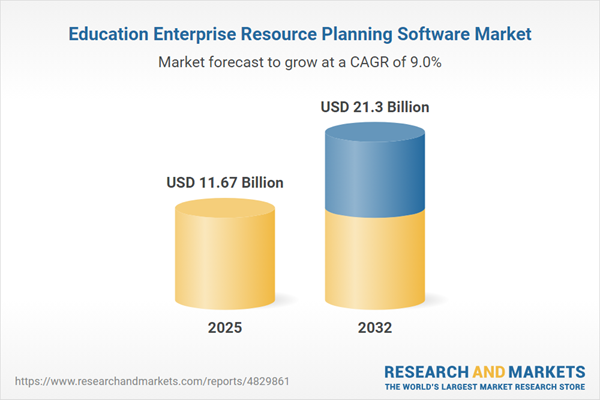Speak directly to the analyst to clarify any post sales queries you may have.
The Education Enterprise Resource Planning Software Market is driving profound change in how institutions manage operations and support digital transformation. Seamlessly integrating technology resources, modern ERP solutions empower senior decision-makers to build resilience, promote efficiency, and enhance stakeholder engagement.
Market Snapshot: Education Enterprise Resource Planning Software Market
In 2024, the Education Enterprise Resource Planning Software Market achieved a valuation of USD 10.70 billion. Forecasts anticipate ongoing expansion to USD 11.67 billion in 2025 and USD 21.30 billion by 2032, reflecting a compound annual growth rate of 8.99%. This upward trend highlights a strong global shift toward agile, digital-first environments. As institutions face mounting pressures to improve operational agility and adapt to new learning paradigms, leadership teams increasingly view ERP adoption as central to institutional modernization, effective compliance management, and broader transformation goals.
Scope & Segmentation
Understanding the varied dimensions of the Education Enterprise Resource Planning Software Market helps senior leaders align ERP investments with institutional goals and future-proof operations. Segmenting the market clarifies solution capabilities and highlights important considerations for deployment, technology, user profiles, and regional priorities:
- Core Components: ERP solutions bring together functions such as learning management, student records, library services, and campus operations. Professional services add value by guiding institutions through system integration, structured staff upskilling, and performance tracking initiatives.
- Deployment Models: Cloud-based ERPs provide scalable infrastructure and reduced maintenance, while on-premises options support direct governance and stricter data control, serving diverse institutional needs and regulatory policies.
- End User Segments: Platforms are tailored for K-12 school systems, universities, vocational learning institutes, and workforce development entities, each with distinct compliance and operational demands.
- Regions Served: Adoption levels and deployment methods differ according to region. Regulatory structures, funding availability, and readiness for cloud adoption influence how the Americas, Europe, Asia-Pacific, Middle East, and Africa pursue ERP implementation.
- Leading Technology Providers: Key companies offer robust data integration, governance, and sector-specific tools. Their service portfolios support a spectrum of institutional challenges and evolving requirements.
Key Takeaways for Senior Decision-Makers
- ERP platforms underpin evolving administrative and academic operations, fostering flexible adaptation to shifting education models and compliance mandates.
- Automation and embedded AI decrease routine manual processing, freeing staff to prioritize high-value planning and program development.
- Cloud-first adoption enhances operational flexibility and facilitates seamless delivery of both remote and hybrid learning models, while reducing direct IT management burdens within institutions.
- Advanced cybersecurity protocols help organizations safeguard sensitive data and maintain compliance with diverse regulatory standards, building trust with stakeholders.
- Digital credentialing simplifies reporting, accelerates individual learner empowerment, and strengthens transparency for oversight bodies.
- Adopting modular ERP frameworks allows institutions to swiftly adjust to policy changes and growing competition in the education sector.
Tariff Impact: U.S. Trade Policies and ERP Software Supply Chains
Changes in U.S. tariff regulations on technology components have introduced new procurement challenges for educational organizations. As a result, many institutions are turning to cloud-based ERP options to lessen the effects of evolving trade policies and enhance procurement predictability. Leading software providers now focus on implementing localized support strategies and robust logistics frameworks, ensuring stable service delivery despite regulatory shifts and supply chain fluctuations.
Methodology & Data Sources
This analysis is based on a blend of executive interviews, extensive market evaluation, regulatory reviews, and independent consultancy expertise. Drawing on input from a wide spectrum of sector stakeholders, the findings offer a comprehensive and objective understanding of the technology and operational trends shaping the education landscape.
Why This Report Matters
- Enables senior leaders to make informed ERP investment decisions, accelerate digital modernization programs, and navigate evolving compliance requirements across education environments.
- Highlights actionable insights on regional technology adoption and best practices, supporting leaders as they respond to varied regulatory and operational contexts.
- Delivers benchmarking guidelines and strategic recommendations designed to amplify efficiency, reduce operational risk, and drive measurable returns on technology investments in educational institutions.
Conclusion
With strategic adoption of Education Enterprise Resource Planning Software, institutions are equipped to optimize administration, improve responsiveness, and evolve in step with sector developments. Leaders leveraging these solutions position their organizations for continued resilience and competitive strength in the changing educational arena.
Additional Product Information:
- Purchase of this report includes 1 year online access with quarterly updates.
- This report can be updated on request. Please contact our Customer Experience team using the Ask a Question widget on our website.
Table of Contents
3. Executive Summary
4. Market Overview
7. Cumulative Impact of Artificial Intelligence 2025
Companies Mentioned
The companies profiled in this Education Enterprise Resource Planning Software market report include:- Ellucian Company L.P.
- Oracle Corporation
- SAP SE
- Workday, Inc.
- Unit4 N.V.
- Jenzabar, Inc.
- Anthology Inc.
- PowerSchool Holdings, Inc.
- Blackbaud, Inc.
- Microsoft Corporation
Table Information
| Report Attribute | Details |
|---|---|
| No. of Pages | 195 |
| Published | November 2025 |
| Forecast Period | 2025 - 2032 |
| Estimated Market Value ( USD | $ 11.67 Billion |
| Forecasted Market Value ( USD | $ 21.3 Billion |
| Compound Annual Growth Rate | 8.9% |
| Regions Covered | Global |
| No. of Companies Mentioned | 10 |









